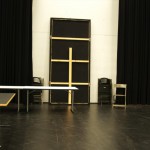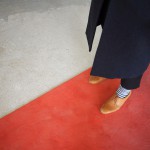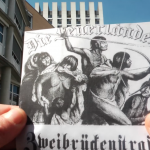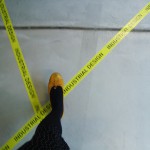Beitrag von Ain Bailey, Soundkünstlerin und DJ, London
An edited version of the presentation given at ZHDK, Session Gender ver/handeln, 6th March 2015
Tracklisting:
1. The Tymes: Miss Grace
2. Evelyn ‘Champagne’ King: Shame
3. Wham: Club Tropicana
4. Fela Kuti: Water Get No Enemy
5. Milton Jackson: Soundtron
6. John Coltrane: Blue Train
7. Ain Bailey: Audition
8. Steve Reich: Clapping
9. Elodie Lauten: Adamantine Sonata
10. Maryanne Amacher: Head Rhythm 1 and Plaything 2
11. The Pitch Sisters Live! @ Iniva, Rivington Place, London
12. Save Lambeth Women’s Project pot banging protest
13. Ain Bailey: Breath
14. Ain Bailey: AGORA: St. George’s, Bloomsbury
Good morning.
Today, I’d like to present a brief overview to the origins and development of my compositional practice. I’ll take as a point of metaphorical reflection my music collection, which has evolved alongside the development of my sound art practice. I shall present to you a sonic timeline of those sounds that I’ve grown up with, and those songs and compositions that I feel have impacted on compositional nurturing. As well as this, I’ll also give a little insight of my compositional process and what that actually entails. Of all the things I’m curious about with folk who make work is literally what is their process, how do they arrive at their artistic outcome?
Ok, let’s begin…
12th August 1963. The date of my birth. No. 1 in the UK charts was “I Like It” by Gerry and The Pacemakers. A beat combo from Liverpool who emerged at the same as that other slightly more familiar group of Scousers – The Beatles. This may be interesting, perhaps even significant, but I’d like to move swiftly on.
My music collection comprising vinyl, CDs and digital materials is extensive. Paltry in comparison to many avid collectors, but there is still the ability to lose oneself in it. It’s even possible to lose a record. Trust me, I’ve done this many times when preparing for a DJ gig and needing a particular record. It’s frustrating and painful to say the least, but I wouldn’t have it any other way. Though I offer a disclaimer here in that I tend to DJ with CDs and downloads, as the weight of large case filled with 70–100 pieces of vinyl is way too heavy. The upside of Djing with digital material is that you have a greater access to songs. Thousands, rather than however many records one is able to fill a large record box with.
As was traditional in West Indian households, and in my specific Jamaican one, those stalwarts of the black musical tradition Jim Reeves, Perry Como et al, were a mainstay for many years. Ok, I’m kidding. For those of you unfamiliar with these singers – these were white, male crooners of easy listening material. I’m most intrigued as to the proliferation of these singers in Caribbean households, but that’s for another presentation.
The first vinyl record I owned was purchased for me by my mother in 1974. It was a 7” single entitled ‚Ms Grace‘ by The Tymes. I’ve no idea where this record is, which is a great shame. While the household in which we lived had a stereogram, I’m not sure that I was ever allowed to touch it, as it was a sacred and expensive item.
My early experience of music was manifold. Home. The church, boarding school and religious assemblies. The dances that were organised by the Brixton Neighbourhood Community Association, where members of my family worked, provided a rich source of far more interesting engagement with music. In this particular instance reggae, ska and soul. This really foregrounded my interest in clubs, and love of dance music in particular.
Then there was the transistor radio and Radio Luxembourg. A private world in which to bury yourself in uncharted waters. Two particular songs stand out from that period: Donna Summer’s “I Feel Love” and Alessi’s ‚Oh Lori‘. Two iconic compositions, which to this day I hear out and about on a regular basis. Home taping might indeed have been killing music, but it was a strategy widely employed by those of us with limited resources, who just needed to be able to listen, repeatedly, to these moments of magic.
This moment, perhaps, explains my enduring fascination with collecting music.
1978. Evelyn ‚Champagne‘ King’s ‚Shame‘ was the first record that I bought with my own pocket money. My first 12” single. Bizarrely I have absolutely no recollection as to the first CD I ever bought. Or my first foray into the digital domain.
From here on in there was no stopping me. The double A-sided reggae 12” with Jimmy Lindsay and Fabian, the funk of Slave, McFadden and Whitehead’s joyful, anthemic soul, various incarnations of Lovers Rock, including Janet Kay, Carol Thompson, and my particular favourite Jean Adebambo. Adebambo, who sadly passed away a few years ago, was important as she was depicted on her album cover with a guitar, and wrote her own songs. This was perhaps was one of my early feminist awakenings. I didn’t want to be her, but I somehow felt that she was different from many of her colleagues, who sung on records written and produced by men, as I discovered much, much later. on.
As well as being a sound artist, I’m also a DJ. My style is an eclectic one, as I become somewhat bored when playing music with the same beat for longer than 30 mins. The range of music I spin ranges from pop, world music, house, both soulful and minimal, jazz, and of course disco, soul and reggae. Pretty much Anything and Everything.
DJing and attempting to generate more work is the primary reason for the transition to becoming a sound artist. A friend had recommended that in order to secure work as a DJ one should either make music and/or produce regular mixes. I enrolled in a number of music technology classes attempting to engage with these new creative tools. Once I had an understanding of the processes involved in creating songs, I attempted to make dance music. The results were pretty bad! Initially disheartened that my future DJ superstardom was slipping away from me, I perked up considerably when Stephanie Thiersch, a friend of a friend contacted me in 2006 wondering if I might be interested in collaborating on a multimedia performance. ‚Beautiful Me‘ saw me work with Stephanie, a choreographer and filmmaker; Maria Stamenkovic Herranz, a ballerina; and Bettina Buck, a fine artist. As well as DJing live for the performances, compositions were created using samples from the BBC sound effects library. This was the first time I’d actually composed and publicly displayed my compositions. I also worked with Stephanie’s company ‚mouvoir‘ on their subsequent production ‚Cactus Bar‘, which again saw me DJing, composing and for the first time appearing on stage as a performer, not anonymous and hidden behind the decks.
Messing with the timeline here, let’s go back a bit. 1989. The first time I actually ever put sound to image or anything for that matter, was for a friend’s short video film featuring a train journey through South London. The composition wasn’t my own, but that of John Coltrane’s track ‚Blue Train‘. The synergy of the two constituent parts was intriguing, and certainly peaked my curiousity. At this point in time I wasn’t intrigued by the world of jazz composition, or any musical composition, but the possibilities of filmmaking.
To this end I embarked on a film/video fine art degree at St Martin’s School of Art. Here the language, composition and materiality of film were key elements that certainly inform my compositions. Here is where I discovered the work of Sergei Eisenstein and the theories of montage developed by him. As well as this, the dreamscapes of Maya Deren, and the experimental works of Stan Brakhage all made a distinct impression upon the work that I create. On a practical level, back in the early 1990s, before the proliferation of digital filmmaking, we worked with 8mm and 16mm film stock, and audiotape. Cutting films on Steenbecks, and recording on reel-to-reel tape machines, can be said to be, of all the influences thus far, by far the most enduring compositional strategy. I have a desire when composing to make cinematic work. No doubt borne out of many afternoons sat in the basement cinema of the beautiful art deco Central St Martins building on Long Acre, which is now an H&M store. I don’t believe that sonic work needs to be accompanied by visual material, in order to give the listener something to do while listening. Works are intended to be epic and cinematic.
So moving on from DJing through to my fledgling works, I also began to listen to more experimental sounds. I’d discovered the work of Steve Reich back in 1985, but didn’t really embrace/understand experimental and modern classical music until the mid-00s. Then I began to relish a new language, new possibilities of making music. Artists such as Eliane Radigue, Maryanne Amacher and William Basinski.
However, despite my earlier protestations I AM very much interested in collaborating with visual artists, as I was fortunate enough to do with Sonia Boyce on the ‚Oh Adelaide‘ installation.
The Devotional Series has been a decade-long project by Sonia Boyce, which began at a women’s group in Liverpool, England. Participants were asked to consider the first record they had purchased, and from there began the creation of a collective memory of black women in British entertainment from the end of the 19th century to the present day. Via word of mouth, members of the general public have been sending information about performers to Boyce to create a roll call of over 200 names. Some of the names featured include: Elisabeth Welch, Winifred Atwell, Adelaide Hall, Cleo Laine, Shirley Bassey, Millie Small, Poly Styrene, Janet Kay, Joan Armatrading, Linda Lewis, Neneh Cherry, Sade, Mica Paris, Des’ree and Leona Lewis. As well as this, Boyce has accumulated a number of sound materials on compact disc, cassette tape and vinyl record, creating alongside the remembrance of black female performers, an aural archive. The collaboration ‘Oh Adelaide’, between Boyce and I, comprises found and re-worked audio and film footage of the jazz singer Adelaide Hall, one of the named performers. In selecting music from the Devotional Collection, a number of issues came to light. First, there was the issue of copyright. In wishing to sample material from the archive, what were the chances of anyone ‘spotting’ the material that had been chosen? Research was carried out as to the feasibility of using an Adelaide Hall clip. It transpired that the clip was still well within the Duke Ellington estates copyright. We didn’t seek permission, fearful were we of rejection. Despite strong reservations about the use of the work of others, we took a decision to forge ahead, as the endeavour was not a profit-making one, but a site on which to discuss the archival material and it’s cultural impact. I wondered about the use of sampled material in other artistic domains, notably that of hip hop. Was the way in which I sampled the material comparable to that of a turntablist? The answer is an unequivocal – yes! Of course, the only difference is the hardware/software that manipulates the material. The question of what to do with the archival material, and how to, in some ways honour it. I’m a fan of many of the artists in the archive, but striving to engage creatively with the material, was in actual fact not a particularly difficult one. Essentially, the issue for me was one of memory. It wasn’t the case that I wanted a literal recognition within the composition of the artists that I had selected, but there was somehow, in processing the material, a residue of their presence – a sonic ectoplasm perhaps. My process is one that usually sees me creating my own material, which is then reworked. Here, I chose between 10 and 15 songs with which to compose. These songs were chosen from across the decades and genres, as I wanted to have a representation of the works within the archive itself, and wasn’t sure if in sticking to a particular genre or period of time, that that might be evident in the final composition. In composing the soundtrack, some material was wrought and restructured beyond recognition. In others, a piano phrase was utilized, and a fragment of a vocal contribution rehashed in a Max/MSP patch produced other-worldly glitchy audio. The songs were digitally treated, as is my method, temporally contracted and elongated resulting in an immersive experience of layered textures. In the process of creating the soundtrack, I only had in mind that it would be presented to accompany Boyce’s images. While the musical genres represented by the artists who form the collection is varied and ranges from classical to drum ‘n’ bass, my compositional persuasion is confined to the experimental realm. There was a great sense of not wanting to represent any one genre, but to create something that would be inclusive and transcend the musical categorisations – a space in which all the artists were represented, albeit in an abstract form. Essentially this meant making a work that was non- representational – a kind of Devotional white noise. John Akomfrah, the director of the film ‘9 Muses’, in an interview with the website soundandmusic states that:
“We’re both very interested in noise, for want of a better word: what Trevor (Mathison) at one point called the “post-soul noise”. These are sounds that take their cue from pre-existing black musics, be it dub or funk, but they’ve been defamiliarised, put through a sonic box that renders them strange and unusual.”
While studying for my Masters at Goldsmiths I made a compositional decision to only use material that I had generated. The processing could be as extreme as I could imagine, but I didn’t want to use pre-existing material, as I had done with early works. Behind this decision lay a quest to finding my own voice. Of course, many of us as creators struggle with this, perhaps on a daily basis, but it was a strategy that I felt compelled to adopt. My blueprint if you will.
I decided to set out on a journey to compose a piece of work, based on a line contained in a film by Leslie Thornton: ‚Peggy + Fred In Hell: The Prologue’. The line was taken from an old American university film, which may in fact be a completely fictitious premise. Nonetheless, the premise is a compelling one. What would a female sonic universe sound like, if we all vocally hung around an A flat below middle C? Once the recordings of 50 or so women had been completed, the compositional challenge became how to compose with such a variety and multitude of voices? Wrangling such a large number of sound objects in the available time period was not without its problems. Should I have stopped at 30 to make the task more manageable? Given my sense of community engagement, it was important that everyone who was recorded was subsequently included in the composition. I concerned myself with the materiality of the recordings, which ranged from the vulnerable, the strident, to the very drunk! All contributions hovered in and around the desired pitch of 207.65 Hz. Aural artifacts exist on the recording as a result of attempting to harmonise the material, but resulting in some dissonance. The differing environmental backgrounds were treated in Pro Tools, so as to enable tracks to sonically sit together more readily. Future iterations of The Pitch Sisters will see participants recorded in the same environment. Even though the environmental information present within the recordings often had to be minimised, it was important for this version of The Pitch Sisters to add to the participants identity by situating them in different locales. This worked with some recordings, and where this was evident, it is included. In making the recordings, and beginning to make compositional decisions – I was minded of both choral and drone music. Normally my process is to wait until the material has been processed, and then see what becomes apparent. Here, there was a real sense of wanting to layer the voices creating modulations and choruses. To create a choir – complete with soloists. The narrative arc of the composition was to begin with the ‘natural’ voice and then to segue into fully processed material – a reflection of my compositional resistance to the straitjacketed notion that women are more desirable based on a nebulous idea. The point wasn’t to make the women appear unattractive! Part I was composed using editing and spatialising tools within Pro Tools and some manipulation to clean the material. The second, processed half was created using Ableton and once effects such as a tremolo and stereo spread had been applied, was mixed live, utilising my skills as a DJ, recorded and imported into Pro Tools. The repetition of the A flat as a compositional device, has antecedents in the work of the compositions of Steve Reich’s, such as ‘Clapping Music’. While ‘Clapping Music’ is scored, the monotone aesthetic of the handclaps renders the composition as containing a singular pitch. Lenka Clayton’s ‘Qaeda Quality Question Quickly Quickly Quiet’ is an incredible work, in which she reconstructs a speech delivered by George W. Bush, recorded soon after 9/11. Clayton painstakingly reorders the speech and places all the words in alphabetical order. Clare Gasson’s ‘The Night’ again uses the idea of text as a list, in which her composition engages with the Women’s Art Library at Goldsmiths, University of London, and in which she names all the artists present within the collection. Much has been written about the female voice within contemporary film theory, and similarities can be drawn with the realm of music composition. Kaja Silverman writing about the female voice in cinema states:
“It has somehow escaped theoretical attention that sexual difference is the effect of dominant cinema’s sound regime as well as its visual regime, and that the female voice is as relentlessly held to normative representations and functions as is the female body”.
In attempting to subvert the notion of ‘the preferred pitch of a woman’s voice’, I have endeavoured, within the narrow confines of the ‘preferred pitch’, to challenge and resist the essentialising of the female voice.
The world of technology spins at a pace faster than many of us can keep up with it. I’ve no interest in technology for technologies sake, but certainly am interested in how to evolve my practice, how to create new sounds/textures/spaces within the compositions. How to keep experimenting/challenging and moving beyond that which I’ve already created. Mine is a pretty lo-fi practice. It’s about making the work, not being restricted by the technology. This is not to undermine those whose research and practice is at the cutting edge of technology. They should be saluted, for the results will certainly trickle down to the rest of us.
At this point in my life it’s about hankering after the space that exists in dub, the monumental dirtiness of a sound that comes from hearing minimal techno on a fabulous sound system; such as Berghain in Berlin. The feel good factor of disco. The soul of r’n’b. The playfulness of pop. The clarity of minimalism and on and on and on. One might ask what is the relationship between the sounds that I love and my own compositional identity/strategy?
Archives are very much of the now. For the most part when we think of archives, we might stereotypically imagine dusty letters, photos and the ephemera of an individuals life gathered in a haphazard way. I was recently at a symposium looking at the Black presence in the visual art collection of the Tate Gallery in London. Discussion led to the question of how do we preserve our own personal archives for future generations, and the importance in doing so. I’m not particularly organised enough in terms of my papers, but certainly it is interesting to think of both my music collection and my compositions being preserved for anyone who might be interested in them in the future. And certainly to understand the journey that I have made as an artist, but also to perhaps illuminate the fact that if I can do this thing called art, so can anyone on the margins.
It’s important to be visible, to share the work, the process, the real struggle of making the work. I’m interested in subjects that speak to my own subjectivity. Being queer, black and female. Issues of the outsider looking in. Enjoying that position: of the other – the hidden. These too are compositional strategies. What incredible building blocks on which to create material.
Further info:
www.ainbailey.com
https://vimeo.com/user6027172







Kommentare von angelawittwer